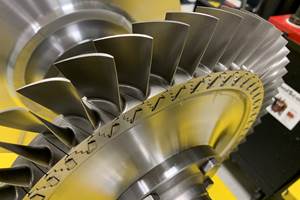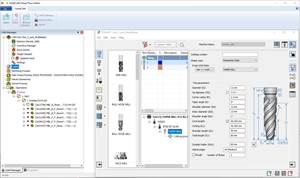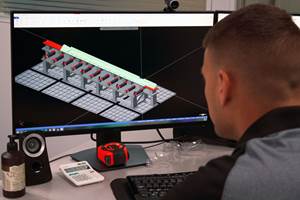CAM Smoothes Project's Ups And Downs
An in-depth look at how a CAM package, along with talent and experience, were applied successfully to a challenging mold job.
Moldmaker Chris Calderone was handed the task of programming tool paths for a pair of 12-up molds to produce the deeply convoluted rubber boots for a major manufacturer's shock absorbers. His toolmaking experience—amazingly extensive for a relative novice—told him the 11 peaks and sharpsided 3/16-inch diameter valleys along the nine-inch mold would challenge a normal machining plan. The machine might even skip over parts of the valleys.
Mr. Calderone also worried about the tool life of the 3/16-inch ball mill over the length of the full cut. If the tool gave out anywhere along the path, the project would have to begin anew—in the middle of any one of the 12 cavities in the 20-inch by 20-inch plate of FM45 high carbon machining steel. Couple that problem with registering the 12 cores at a uniform 0.040-inch from the top and bottom cavity walls and you have the makings of a project that would challenge a veteran programmer/machinist...but 17-year-old Chris Calderone completed the project on time and right the first time around.
Chris Calderone began as CAM programmer for AMC Toolworks in Hulmeville, Pennsylvania. AMC is a producer of molds for the rubber mechanical goods industry. At 15, the younger Calderone convinced his father that investing in Mastercam (CNC Software, Inc., Tolland, Connecticut) for the company, founded by the senior Calderone 15 years ago, would pay dividends in productivity and quality.
It soon did. The elder Calderone recalls, "We got a job in with lots of contours and we weren't happy with the older CAM product we had been using." Anthony Calderone says his son"...took eight hours from when we first got Mastercam until he programmed the tool path for that customer's mold."
Chris Calderone has been improving AMC's output using the continuing upgrades of the program ever since. The rubber boot project for Manviller Rubber Products was one more job that justified Mr. Calderone's faith in Chris' ability to make profitable use of Mastercam. "Buying Mastercam was the best move I ever made," says Anthony Calderone.
AMC received a 2D drawing of the curve of the bellowslike boot from Manville's Mark Gejewski in a DXF file. Chris Calderone brought it into Mastercam without a hitch. Other moldmakers confirm that the program lets them import IGES, ACIS (solids), CADL, VDA, DWG—virtually any format—with ease.
Chris Calderone laid out the 12cavity plates, one pair to be milled by each of two Comet mills, in 2D. He set up the cavity spacing and designed the bosses outside the ends of the cavities to register the cores. Next, he used Mastercam's built-in CAD modeler to create the surfaces for one cavity, complete with the shrinkage specified by the rubber manufacturer.
He rotated the outside contours about the center axis of the part, creating half of the finished part needed for the A and B plates. To avoid excessive tool wear and to cut the deep cavities correctly, he chose to machine the 90surface model with 12 different operations. A quick onscreen verification of his strategy confirmed that the tool paths would work correctly.
Swinging the 3/16-inch ball mill along the X and Y axes, Chris Calderone cut the major diameter—the bottoms of the convolutions in the molds; the widest parts of the finished product. He specified 20 passes from the surface, with a Zstep amount of 0.010-inch. He left 0.020-inch for subsequent finish passes. Chris Calderone then cut the minor diameter axially along the cavity, again to 0.020-inch of the finished dimension.
To create the tapered sides of the convolutions, joining the major and minor diameters, he applied the Mastercam-programmed tool path derived from the customer's curve. Again anticipating the eventual failure of the 3/16-inch ball mill along the complex curve, Chris Calderone started the first pass 0.025-inch down the Zaxis from the surface and Zstepped 0.010-inch down to 0.020-inch from the finish dimension.
To finish each cavity, he programmed two passes to within 0.005 of finish, in 0.007 stepovers, and the finish pass in 0.003 stepovers. This routine was repeated for 12 cavities in each of the four plates. AMC's two machines ran 24,000 passes on each plate over four days.
Mastercam came into play again as Chris Calderone designed, and then programmed the tool path for a cavity in each plate to accept the cross members and "trunk" of the "tree" which would tie 12 separate cores into a solid unit. The tree was made with one tapered side to achieve the accurate registration needed to produce a uniform 0.040-inch material thickness in production. Corresponding recesses for locating core bosses were also cut in the cavity plates to register the cores precisely congruent to the cavities' axes.
Turning the mold cores was young Chris Calderone's first experience with Mastercam Lathe, though he had been turning out first quality product for AMC using Mastercam Mill. The senior Calderone, reliant on his son to keep AMC Toolworks at a very competitive level, admits, "I don't know the first thing about the program. So it's great that whenever Chris needs answers, our local Mastercam dealer is right there to help him."
48 cores—double the number of cavities—were ordered so AMC's customer could continue molding while one set of shock absorber boots cooled. Chris Calderone decided that turning two cores at a time for the opposing cavities would create intolerable vibration so he turned one nine-inch core at a time; the cores would be joined in pairs. Lefthand cores had a shaft extension fit into corresponding drilled and tapped holes in the opposing cores, then to be held in two rows of six by the tree.
Mastercam scaled down the original, convoluted curve 0.040-inch for the cores, to create the finished rubber part's thickness. Now, what had been a challenge to cut the deep convolutions in the cavities reversed itself in the cores. "I did the same as with the cavities," Chris Calderone says. "I used one tool to hog out most of the material." Then, beginning 0.100 from the finish tool path, he took two passes to within 0.050, then 0.010-inch, and finally to zero. "Even though this was my first time using Mastercam Lathe," he reports, "it was an easy transition from Mastercam Mill because the command structure—the interface—is essentially the same."
Anthony Calderone is, after three years, still in awe of his son's adaptation to the Mastercam mind set. "If the documentation says Mastercam will do something, Chris wants to make it do it. If it's in the realm of possibility," he says with obvious pride, "he wants to push the envelope."
Apparently, Mastercam has met the Calderone challenge, providing Chris with programming tools which keep pace with his ever-expanding imagination. While Calderone, Sr., has since closed AMC operations and embarked on an entrepreneurial pursuit, Chris is now programming for another toolmaking company, proof of the ready marketability of one's Mastercam mastery at any age. MMS
Related Content
How this Job Shop Grew Capacity Without Expanding Footprint
This shop relies on digital solutions to grow their manufacturing business. With this approach, W.A. Pfeiffer has achieved seamless end-to-end connectivity, shorter lead times and increased throughput.
Read MoreIntegrated CAD/CAM Promotes Process Efficiency, Traceability
High-requirement markets are not only searching for good parts — they're searching for proof of good parts. CAD/CAM software can help.
Read MoreBuilding A Powerful Bridge from the CAM Programmer to the Shop Floor Operator
SolidCAM for Operators provides a powerful bridge from CAM programming to the shop floor to best streamline the machine shop process with its CAM part simulation. It provides a clear picture to the operator for setup and prove-out, enables minor G-Code changes and avoids crashes, broken tools and scrapped parts.
Read MoreLarge-Format Machining With Small Cutting Tools and Dynamic Motion
Napoleon Machine, a defense contractor that provides parts for the M1 Abrams tank, recently took advantage of a CAM feature that allowed the company to streamline its cutting strategies and program offline. Here’s how the shop cut cycle times nearly in half with its large-format five-axis machining operations.
Read MoreRead Next
3 Mistakes That Cause CNC Programs to Fail
Despite enhancements to manufacturing technology, there are still issues today that can cause programs to fail. These failures can cause lost time, scrapped parts, damaged machines and even injured operators.
Read MoreThe Cut Scene: The Finer Details of Large-Format Machining
Small details and features can have an outsized impact on large parts, such as Barbco’s collapsible utility drill head.
Read More















.png;maxWidth=300;quality=90)













